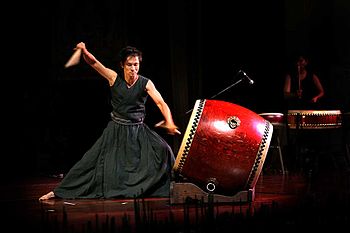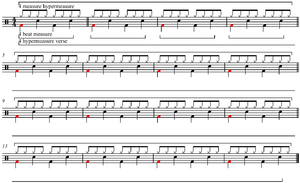- Beat (music)
-
For other uses, see Beat (disambiguation).
The beat is the basic unit of time in music, the pulse of the mensural level[1] (or beat level).[2] In popular use, the beat can refer to a variety of related concepts including: tempo, meter, rhythm and groove. In hip hop and R&B music, the term 'beat' commonly refers to the non-vocal layer of the song not including instrumentals, which is frequently based on a looped recording of a drum-rhythm. Much music is characterized by a repeating sequence of stressed and unstressed beats (often called "strong" and "weak") and divided into measures organized by time signature and tempo indications.
Contents
Downbeat
The downbeat is the impulse that occurs at the beginning of a bar in measured music.[3] Its name is derived from the downward stroke of the director or conductor's baton on the first beat of each measure. It frequently carries the strongest accent of the rhythmic cycle. However, in some cases, the downbeat may not be emphasized. Such departure from the normal stress pattern of a measure is a form of syncopation.
Upbeat
(Ger. Auftakt).
1. An unaccented beat or beats that occur before the first beat of the following measure. In other words, this is an impulse in a measured rhythm that immediately precedes, and hence anticipates, the downbeat. It can be the last beat in a bar where that bar precedes a new bar of music.[4]
2. An anticipatory note or succession of notes occurring before the first barline of a piece, sometimes referred to as an ‘upbeat figure’, section or phrase. An alternative expression is "anacrusis" (from Greek. ana: "up towards" and krousis: "to strike"; Fr. anacrouse). This term was borrowed from poetry where it refers to one or more unstressed extrametrical syllables at the beginning of a line.[4]
3. The upward stroke made by a conductor to indicate the beat that leads into a new measure.
N.B. This expression is sometimes loosely used outside the field of music to denote anything positive-sounding; e.g. an "upbeat assessment of a company's prospects"
On-beat and off-beat
In music that progresses regularly in 4/4 time, counted as "1 2 3 4, 1 2 3 4...", the first beat of the bar (down-beat) is usually the strongest accent in the melody and the likeliest place for a chord change, the third is the next strongest: these are "on" beats. The second and fourth are weaker - the "off-beats". Subdivisions (like eighth notes) that fall between the pulse beats are even weaker and these, if used frequently in a rhythm, can also make it "off-beat".[7] The effect can be easily simulated by evenly and repeatedly counting to four: Bold denotes a stressed beat. As a background against which to compare these various rhythms a bass drum strike on the downbeat and a constant eighth note subdivision on ride cymbal have been added, which would be counted as follows:
- 1 2 3 4 1 2 3 4 --
 play eighth notes and bass drum alone (help·info)
play eighth notes and bass drum alone (help·info) - 1 2 3 4 1 2 3 4—the stress here on the "on" beat
 play (help·info) But one may syncopate that pattern and alternately stress the odd and even beats, respectively, creating syncopation:
play (help·info) But one may syncopate that pattern and alternately stress the odd and even beats, respectively, creating syncopation: - 1 2 3 4 1 2 3 4 -- the stress is on the "unexpected" or syncopated beat
 play (help·info)
play (help·info)
So Off-beat is a musical term commonly applied to syncopation that emphasizes the weak even beats of a bar, as opposed to the "normal" on-beat. This is a fundamental technique of African polyrhythm that transferred to popular western music. According to Grove Music, the “Offbeat” is [often] where the downbeat is replaced by a rest or is tied over from the preceding bar".[7] The downbeat can never be the off-beat because it is the strongest beat in 4/4 time.[8] Certain genres in particular tend to emphasize the off-beat. This emphasis is a defining characteristic of rock'n'roll and Ska music.
Backbeat
 Back beat[9]
Back beat[9] It's got a backbeat, you can't lose it - Chuck Berry
It's got a backbeat, you can't lose it - Chuck Berry
A back beat, or backbeat, is a syncopated accentuation on the "off" beat. In a simple 4/4 rhythm these are beats 2 and 4.[10] Emphasized back beat, a feature of some African styles, defined rhythm and blues recordings in the late 1940s and so became one of the defining characteristics of rock and roll and much contemporary popular music.
An early record with an emphasised back beat throughout was "Good Rockin' Tonight" by Wynonie Harris in 1948.[citation needed] However drummer Earl Palmer claimed the honour for "The Fat Man" by Fats Domino in 1949, which he played on, saying he adopted it from the final "shout" or "out" chorus common in Dixieland jazz. However urban contemporary gospel was stressing the back beat much earlier with hand-clapping and tambourines. There is a hand-clapping back beat on "Roll 'Em Pete" by Pete Johnson and Big Joe Turner, recorded in 1938. A distinctive back beat can be heard on "Back Beat Boogie" by Harry James And His Orchestra, recorded in late 1939.[11] Other early recorded examples include the final verse of "Grand Slam" by Benny Goodman in 1942 and some sections of The Glenn Miller Orchestra's "(I've Got A Girl In) Kalamazoo", while tapes of Charlie Christian jamming at Minton's Playhouse around the same time have a sustained snare-drum back-beat on the hottest choruses.
In the mid 1940s "hillbilly" musicians the Delmore Brothers were turning out boogie tunes with a hard driving back beat, such as the #2 hit "Freight Train Boogie" in 1946, as well as in other boogie songs they recorded.[13] Similarly Fred Maddox’s trademark back beat, a slapping bass style, helped drive a rhythm that came to be known as rockabilly, one of the early forms of rock and roll.[14] Maddox had used this style as early as 1937.[15]
In today's popular music the snare drum is typically used to play the backbeat pattern.[5] Early funk music often delayed one of the backbeats so as, "to give a 'kick' to the [overall] beat".[12]
Some songs, such as The Beatles' "Please Please Me" and "I Want to Hold Your Hand", The Knack's "Good Girls Don't" and Blondie's cover of The Nerves' "Hanging on the Telephone", employ a double backbeat pattern.[16] In a double backbeat, one of the off beats is played as two eighth notes rather than one quarter note.[16]
Hyperbeat
A hyperbeat is one unit of hypermeter, generally a measure. "Hypermeter is meter, with all its inherent characteristics, at the level where measures act as beats."[17]
Related concepts
- Afterbeat refers to a percussion style where a strong accent is sounded on the second, third and fourth beats of the bar, following the downbeat.[10]
- In Reggae music, the term One Drop reflects the complete de-emphasis (to the point of silence) of the first beat in the cycle.
- James Brown’s signature funk groove emphasized the downbeat – that is, with heavy emphasis "on the one" (the first beat of every measure) – to etch his distinctive sound, rather than the back beat (familiar to many R&B musicians) which places the emphasis on the second beat.[18][19][20][21][22]
See also
References
- ^ Berry, Wallace (1976/1986). Structural Functions in Music, p.349. ISBN 0-486-25384-8.
- ^ Winold, Allen (1975). "Rhythm in Twentieth-Century Music", Aspects of Twentieth-Century Music, p.213. Wittlich, Gary (ed.). Englewood Cliffs, New Jersey: Prentice–Hall. ISBN 0-13-049346-5.
- ^ "Downbeat". Grove Music Online. 2007. http://www.grovemusic.com. Retrieved 2007-02-10.
- ^ a b DOGANTAN, MINE (2007). "Upbeat". Grove Music Online. http://www.grovemusic.com. Retrieved 2007-02-10.
- ^ a b Schroedl, Scott (2001). Play Drums Today!, p.11. Hal Leonard. ISBN 0-634-02185-0.
- ^ Snyder, Jerry (1999). Jerry Snyder's Guitar School, p.28. ISBN 0739002600.
- ^ a b "Beat: Accentuation. (i) Strong and weak beats.". Grove Music Online. 2007. http://www.grovemusic.com. Retrieved 2007-02-10.
- ^ "Off-beat". Grove Music Online. 2007. http://www.grovemusic.com. Retrieved 2007-02-10.
- ^ "Introduction to the 'Chop'", Anger, Darol. Strad (0039-2049); 10/01/2006, Vol. 117 Issue 1398, p72-75.
- ^ a b "Backbeat". Grove Music Online. 2007. http://www.grovemusic.com. Retrieved February 10, 2007.
- ^ The Ultimate Jazz Archive - Set 17/42
- ^ a b Mattingly, Rick (2006). All About Drums, p.104. Hal Leonard. ISBN 1-4234-0818-7.
- ^ http://partners.academic.ru/dic.nsf/enwiki/611095[dead link]
- ^ NPR News Riding the Rails to Stardom - The Maddox Brothers and Rose
- ^ "The Maddox Bros & Rose". Rockabilly Hall of Fame. http://www.rockabillyhall.com/MaddoxRose.html. Retrieved June 29, 2011.
- ^ a b Cateforis, C. (2011). Are We Not New Wave?: Modern Pop at the Turn of the 1980s. University of Michigan Press. pp. 140–141. ISBN 9780472034703.
- ^ Neal, Jocelyn. Wolfe, Charles K., and James E. Akenson (eds.) (2000). "Songwriter's Signature, Artist's Imprint: The Metric Structure of a Country Song", p.115, Country Music Annual 2000. Lexington, KY: University Press of Kentucky. ISBN 0813109892.
- ^ Pareles, Jon (2006-12-25). "James Brown, the ‘Godfather of Soul’, Dies at 73". New York Times. http://www.nytimes.com/2006/12/25/arts/music/25cnd-brown.html?pagewanted=2&ei=5088&en=91af3e9694363d10&ex=1324702800&partner=rssnyt&emc=rss. Retrieved 2007-01-10.
- ^ Gross, T. (1989). Musician Maceo Parker (Fresh Air WHYY-FM audio interview). National Public Radio. Retrieved January 22, 2007.
- ^ Lessons in listening - Concepts section: Fantasy, Earth Wind & Fire, The Best of Earth Wind & Fire Volume I, Freddie White. (1998, January). Modern Drummer Magazine, pp. 146–152. Retrieved January 21, 2007.
- ^ According to the New York Times, by the "mid-1960s Brown was producing his own recording sessions. In February 1965, with “Papa’s Got a Brand New Bag,” he decided to shift the beat of his band: from the one-two-three-four backbeat to one-two-three-four. “I changed from the upbeat to the downbeat,” Mr. Brown said in 1990. “Simple as that, really.”
- ^ According to Maceo Parker, Brown's former saxophonist, playing on the downbeat was at first hard for him and took some getting used to. Reflecting back to his early days with Brown's band, Parker reported that he had difficulty in playing "on the one" during solo performances, since he was used to hearing and playing with the accent on the second beat.
Further reading
- de Momigny, Jérôme-Joseph (1821). La seule vraie théorie de la musique. Paris.
- Riemann, Hugo (1884). Musikalische Dynamik und Agogik. Hamburg.
- Lussy, Mathis (1903). L’anacrouse dans la musique moderne. Paris.
- Cone, Edward T. (1968). Musical Form and Musical Performance. New York: W. W. Norton. ISBN 0393097676.
Rhythm and meter Additive and divisive · Beat · Composite rhythm · Counting · Cross-beat · Duration · Groove · Meter · Polyrhythm · Pulse · Rhythmic gesture · Rhythmic unit · Swing · Syncopation · Tempo · Time scale · Time signatureMusical notation and development Staff 
Notes Accidental (Flat · Natural · Sharp) · Dotted note · Grace note · Note value (Beam · Note head · Stem) · Pitch · Rest · Tuplet · Interval · Helmholtz pitch notation · Letter notation · Scientific pitch notation
Articulation Development Coda · Exposition · Harmony · Melody · Motif · Ossia · Recapitulation · Repetition · Rhythm (Beat · Meter · Tempo) · Theme · Tonality · Atonality
Related Categories:- Percussion performance techniques
- Popular music
- Rhythm
- 1 2 3 4 1 2 3 4 --
Wikimedia Foundation. 2010.






